Physical Address
1 Riverwood Drive
Moncks Corner, SC 29461
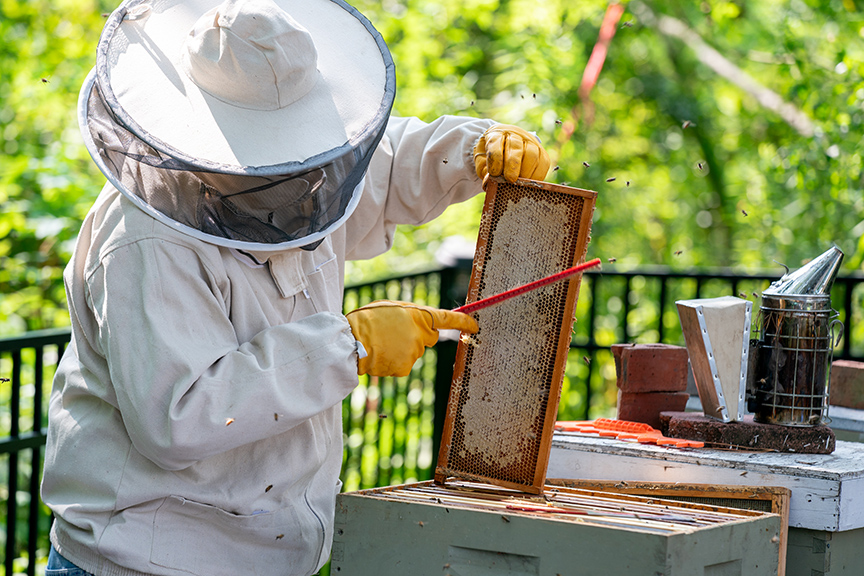
Imagine a world where, as you rise from your bed to start your day, you immediately sense something isn’t quite right. You make your way to the kitchen for your morning cup of coffee, only to find that you are out of coffee, so you settle for tea and reach for the honey. Adding to your frustration, there’s no honey to be found so you pour in some sugar and get ready for work.
On your way to work, the soothing morning song of your flighted friends is absent, and the world seems a bit muted. The beautiful fields of sunflowers and other colorful wildflowers that accompanied you on your drive are all but gone. You make it through your day and stop at the store on your way home, but what fresh produce is left on the shelves is astronomically priced, as are many of the other foods you shop for.
This example may seem a little farfetched, but in reality, all of these impacts and many more would be a direct result of the loss of one powerful pollinator — the honeybee. Indirectly, the list is even more extensive, including far-reaching economic implications, job losses in the agricultural field, and even impacts on human health due to the role that honeybees play in pollinating medicinal plants and herbs.
According to the Food and Agriculture Organization of the United Nations, global honeybee populations have been declining since the 1990s. In South Carolina, though, we’re starting to turn that tide. Thanks, in part, to folks who moonlight as beekeepers, South Carolina’s honeybee colonies are on the rise. Two of the state’s beekeepers, who are also Santee Cooper team members, are working to save the honeybee and are buzzing to share their passion for pollinators.
Guarding the Hive
“Beekeeping is the most rewarding, most frustrating hobby I believe there is,” said Beezie Fleming, who works as an Administrative Associate at Santee Cooper’s Old Santee Canal Park. And she should know; Fleming has been keeping bees for nearly 30 years.



When she first began her beekeeping journey back in 1996, Fleming was the only female and the only participant younger than 60 in her local beekeeping group. She recalled the older gentlemen speaking about how easy the hobby was “in the good old days” when the only requirement was setting boxes out and collecting the honey once a year. That may have been true then, but times have changed.
“Keeping bees for honey or other materials from the hive is a lot more work than most people realize,” said Fleming. This is partly due to many challenges the modern honeybee faces.
Some of these challenges include colony collapse disorder, which began killing off many hives in the early 2000s. Initially unexplained, now it is believed to be caused by pesticides or viruses. Wax moths and the small hive beetle are also detrimental to honeybees. The moths invade a weakened hive and tunnel through the honeycombs, eventually destroying the hive. Likewise, the small hive beetle can take over a weakened hive and cause bees to starve to death by ruining their food supplies.
The main cause of weakened colonies and the No. 1 killer of honeybee populations in general, however, is the Varroa mite.
Fleming explained that the mites feed on bees when in their larval and pupal state before they hatch, causing them to be born with deformities, viruses and weakened immune systems. The viruses spread throughout the colony, causing the bees to be born weaker and unable to resist other sicknesses and pests. Their lifespans are shortened as a result, and they aren’t able to forage as long or far for food storage.
Originally from Asia, Varroa mites were introduced to the United States in the late 1980s through the ports after hitching a ride on the produce imported from other countries. Interestingly, the honeybee isn’t native to the United States either. The bees were brought here from Europe in the 1500s and were commonly referred to as the “White Man’s Fly” by Native Americans.
One way to combat the Varroa mite is to welcome honeybees from yet another country.
“Most beekeepers use Italian bees because they are known to be the most gentle and prolific,” said Fleming. “Because of Varroa mites, a lot of beekeepers have incorporated Russian bees.”
Fleming explained Russian bees, although more aggressive, are more hygienic than their Italian counterparts. They do a better job of keeping the colony clean and are more diligent about removing mites from larvae and adult bees.
The Swarm: Understanding the Intricacies of Bee Colonies
Another challenge to bees and beekeepers is swarming, which occurs when the hive isn’t large enough to support the colony. When a hive becomes overcrowded, the resources needed to keep the colony alive become scarce and cause the overall health to decline. That causes the worker bees to begin raising a new queen and cutting back on feeding the current one, so the new queen can be fit enough to relocate with half the population.
Senior Safety Specialist David Benenhaley has benefited from a swarm or two. Although he originally bought Italian bees to get started, he collected two of his hives from a swarm in a co-worker’s chimney.

“They’ll look for a dark place,” said Benenhaley. He climbed to the roof and removed the cap from the chimney. “When I cut the cap off, there were thousands of bees hanging off of it.”
He shook the bees into his box and was fortunate enough to capture the queen. Once the queen found her new home, the rest of the bees marched in like an army. This particular swarm was so large that he split it into two hives. This was possible because the colony recognized the need and raised another queen to support it.
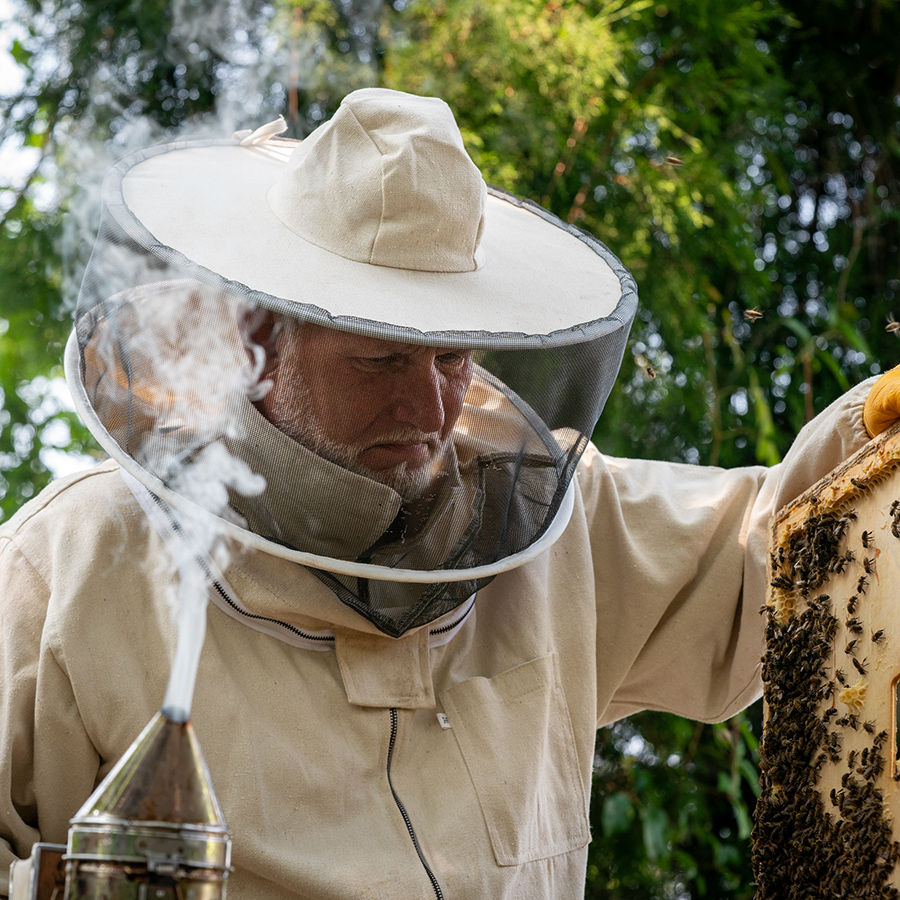
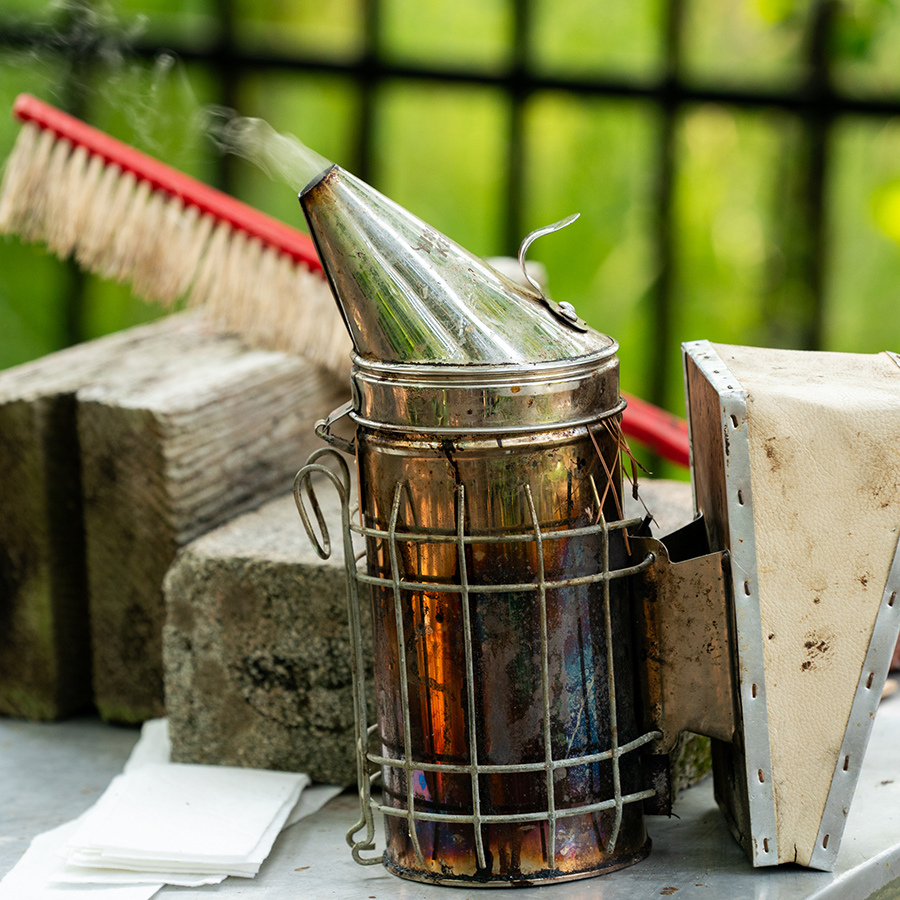
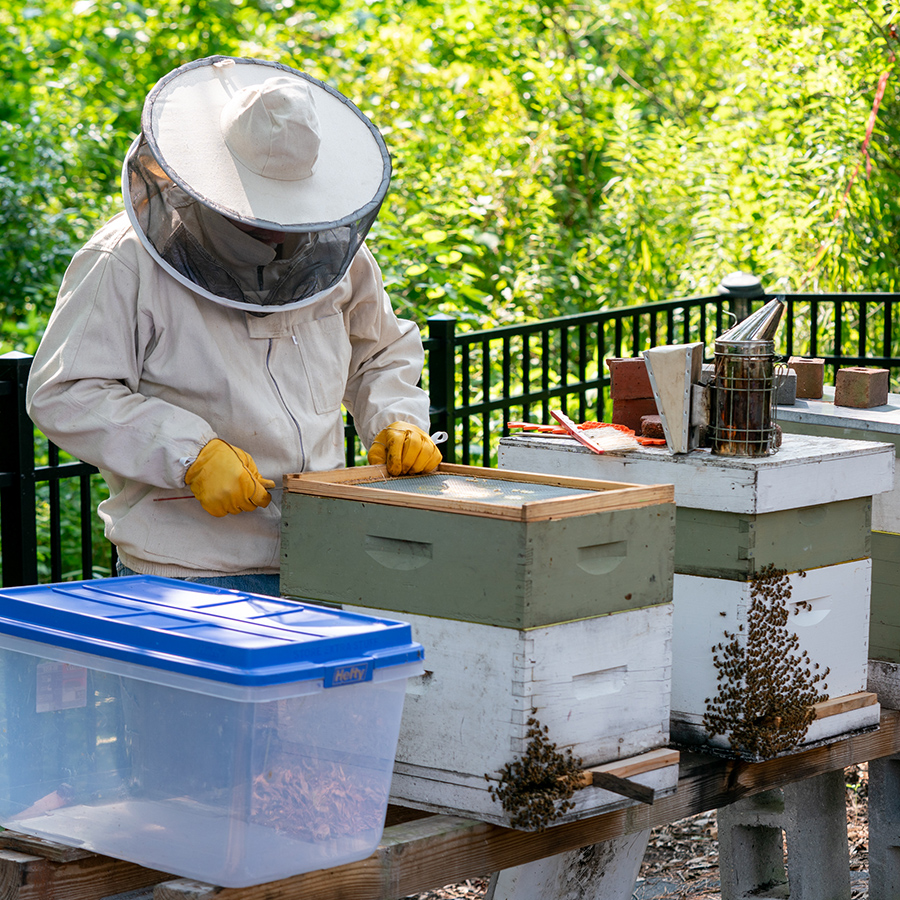
Working for Santee Cooper has been beneficial to Benenhaley’s beekeeping. Recently, a line technician was cutting a pole down and discovered a hive living inside.
“I told them I’d come get it,” said Benenhaley. So, they set the hive in the woods until it could be picked up and join the other hives in Benenhaley’s yard.
Sweet Relief from Seasonal Sneezing
Both Benenhaley and Fleming had similar experiences with one beekeeping benefit, and many people in the South can appreciate it. Although the case for local honey benefiting those with allergies is much debated, anecdotally the families of our two beekeepers have seen dramatic impacts. Interestingly, it’s not always all about the honey.
“I got into beekeeping to have local honey for a family member who suffered from allergies,” said Fleming. “In our experimenting within our family, we found the local pollen was way more effective in relieving allergy symptoms — it even relieved the snoring if taken daily!”
Fleming also explained the downside to treating allergies with pollen is that it’s more labor intensive, and you have to limit how much you take from the colony.
“You can’t collect it all the time because that’s what the baby bees eat,” she said.
Some people also aren’t able to take pollen because it affects them like a “super caffeine,” according to Fleming. She continued to explain for those who are tolerant, the benefits of pollen can include a remarkable nutritional profile, anti-inflammatory properties, and a boost to the immune system.
A Chance Encounter
Over the years, Fleming’s hobby has brought her plenty of joy and some unique experiences. At Old Santee Canal Park, she has the pleasure of meeting all kinds of people from all over the country. One day, a couple from Kentucky stopped by the park and, during their conversation, the topic turned from wanderlust to bucket lists. As fate would have it, experiencing the bustling energy of a beehive was a dream the wife had. The serendipitous encounter was as sweet as honey.
With warmth and kindness radiating from her heart, Fleming seized the moment and extended a surprising invitation. Eager to take advantage of Fleming’s generosity, the couple met her at the hives and suited up in protective beekeeper suits for their unexpected adventure. The husband, appreciating the beauty from a slight distance, aimed his camera, capturing the fleeting moments of joy.
Deeply touched by the kindness given to them, the couple sent a token of their appreciation through the mail a week later — a watercolor painting that breathed life into their shared adventure. The canvas, displaying the image her husband captured and brought to life by the wife’s skilled artistic ability, became a testament to their shared experience.

Liquid Gold
Even though beekeeping can be a lot of work, the proverbial juice is more than worth the squeeze. Both of our beekeepers collect and sell the honey their bees work hard to produce.
“When it comes harvest time, every year is like a miracle,” said Fleming.
And this isn’t an exaggeration. On average, it takes a worker bee an entire lifetime to produce only one twelfth of a teaspoon of honey. Considering that some harvests can produce gallons of honey, that’s nothing short of a true miracle. Of course, there are many variables when it comes to the quantities collected.



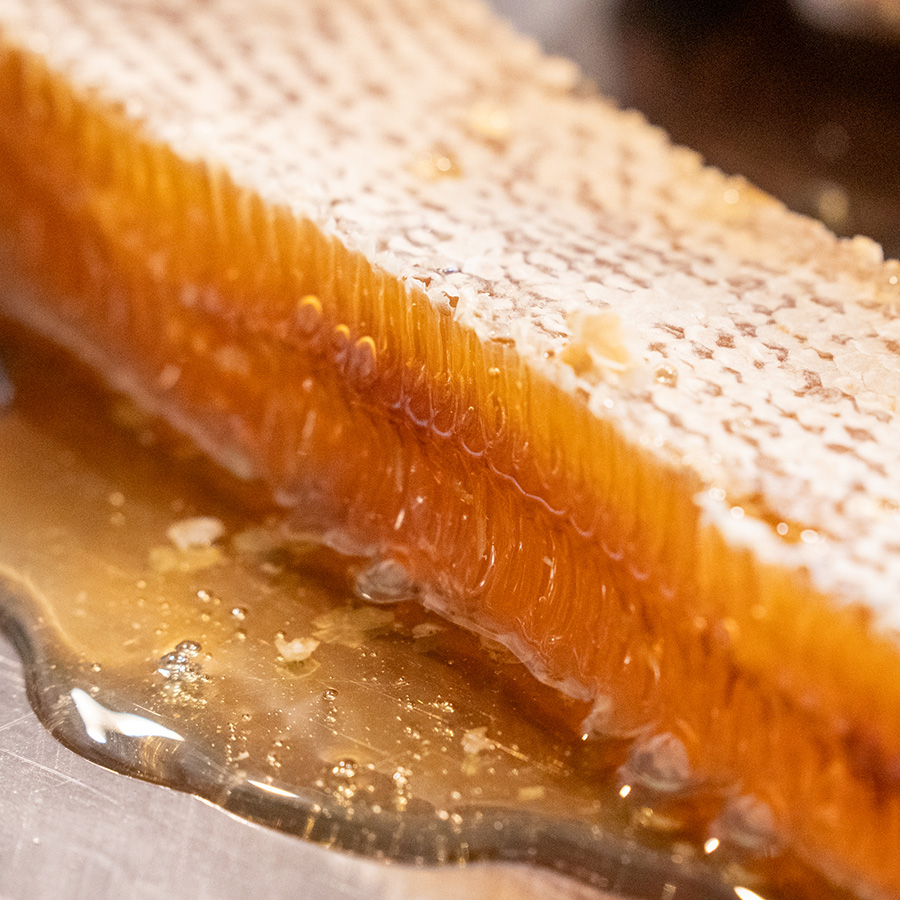
“It changes every year because it’s like any other farming,” said Fleming.
She explained nectar collection depends upon the weather and colony health. A particularly rainy spring can cut down on foraging and, if the weather impacts the plants from which bees get food sources, that can affect the beekeepers’ surplus. Also, if the bee population is low due to mites or other health issues, bees will not produce a good “crop.”
Collecting the honey isn’t as easy as just dipping your hand in a hive like Winnie the Pooh, either. The process takes an understanding of what is needed and what needs to be left behind. Prior to harvesting, the hives need to be inspected to ensure they are strong before the process begins.
The honeycombs are carefully removed and prepared for extraction by uncapping — or getting rid of a thin layer of wax that seals the honey cells. The frames are then placed in a device called a honey extractor, which uses centrifugal force to spin the frames rapidly. As the frames spin, the honey is flung out of the cells and collects at the bottom of the extractor. The honey can then be drained out through a valve.
Once the honey is filtered, it’s ready for packaging and storage. Beekeepers typically pour or bottle the honey into jars or containers, labeling them with necessary information, such as the type of honey, the harvest date, and any special instructions. The honey is stored in a cool and dry place to maintain its quality.
Most importantly, beekeepers prioritize sustainability and the well-being of the bees. They leave sufficient honey for the bees to survive and maintain a healthy hive throughout the year. Honey harvesting is typically done when there is an excess of honey, ensuring the bees have enough resources to thrive.
Last year was good to Benenhaley as he was fortunate enough to harvest an impressive 50 gallons of honey from his six hives.
“I sell it and give it to family members, and I definitely can’t keep it due to the demand,” he said.
The importance of honeybees and beekeeping cannot be underestimated. The loss of honeybees would have far-reaching consequences, affecting not only the availability of honey but also impacting various aspects of our daily lives.

In a world where honeybees face numerous challenges, the dedication and passion of beekeepers like Fleming and Benenhaley offer hope for the preservation and resurgence of these vital pollinators. By nurturing honeybee colonies and promoting sustainable beekeeping practices, they contribute to the health of ecosystems, agriculture and human well-being. It is through their efforts and the support of individuals and communities that we can protect and appreciate the invaluable role of honeybees in our world.
Providing Powerful Pollinator Habitats
Santee Cooper continues its intentional effort to support the state’s pollinators. Through its creative work in rights of way, solar farms and Camp Hall Commerce Park, the Santee Cooper team is creating lasting habitats for bees and butterflies.
The Jamison Solar Site, a 1.2-megawatt facility located on 5.4 acres near the I-26 and Hwy 601 interchange in Orangeburg, became South Carolina’s first Gold Certified Solar Habitat site in December 2021. In order for that site to become a Gold Certified Solar Habitat, Santee Cooper had to commit to planting a diversity of native flowering plants underneath and around the site’s 4,482 solar panels. The planting of native pollinator plant species aids in reducing soil erosion, protecting water quality and enhancing the aesthetic beauty of a solar site. That’s in addition to the ecological value it provides for pollinators such as bees, butterflies, moths, birds and more.
At Camp Hall, Santee Cooper is creating and maintaining an environment that supports and encourages the natural habitat of coastal South Carolina. Nearly 28% of the entire site will be preserved, and a recently completed “Pollinator Pathway” is already blooming for birds, bees and butterflies. In addition to restoring wetlands, the utility is creating more than 15 miles of a multi-use trail system that will provide a place for the local workforce to walk, run, bike and appreciate nature.
Within many of its rights of way, Santee Cooper is encouraging native flora, that doesn’t inhibit power flow, to thrive instead of clear-cutting the area, giving pollinators another natural habitat in which to thrive.